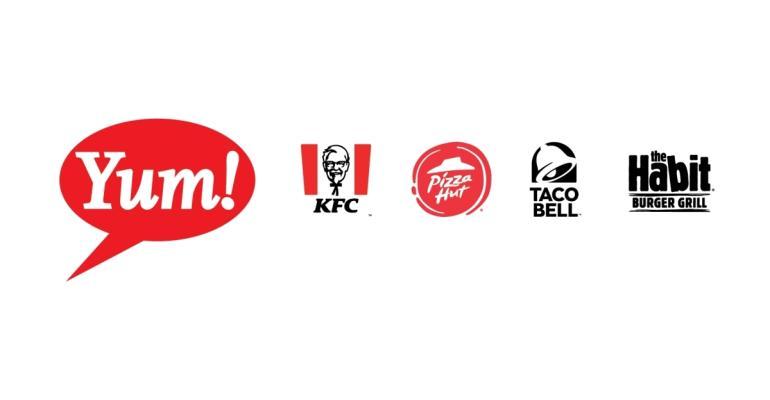On paper, it was a tough first quarter for Yum Brands, with missed Wall Street expectations as global same-store sales declined by 3%, marking the restaurant company’s first negative quarter since 2020. In the U.S., every brand except Taco Bell (up 2%) turned in negative comps. KFC U.S. declined by 7%, Pizza Hut declined by 6%, and The Habit Burger Grill declined by 7%.
During the company’s earnings call Wednesday morning, however, executives were somewhat upbeat, touting the resiliency of the company’s brands in a challenging operating environment and pointing to core operating profit gains and digital sales increases as reasons for their optimism. Additionally, executives cited sequential improvements from January’s weather impacts, as well as easing headwinds from tension in its Middle East markets.
Technology was the focal point of that optimism, with CEO David Gibbs noting that Q1 marked the first time the Yum system surpassed over 50% in digital sales, representing about $30 billion in annualized, digital sales. These sales were driven by the continued rollout of Click and Collect and kiosks.
“The first phase of this journey began in earnest in 2019. While we have further to go, we have achieved critical mass in several areas,” Gibbs said. “Deployment in the first phase has driven an increase in digital sales from about 20% in 2019 to over 50% now and the impact has been significant.”
That impact, he added, includes higher frequency and check sizes from consumers and stronger unit economics for franchisees. Taco Bell U.S. has the most extensive deployment of Yum’s key platforms, he added, including its proprietary point-of-sale and ecommerce systems, as well as a new inventory management platform to help store managers. Yum is now rolling into a “second parallel phase” of its technology journey and that is the acceleration of artificial intelligence combined with its data assets.
“We currently have more than 40 AI initiatives in progress across the company in marketing, operations, insights, engineering and internal back-of-office functions,” Gibbs said.
One example is voice AI at the drive-thru, which Yum has been testing at five Taco Bell restaurants in California. The company is expanding the test into 30 restaurants in Q2 based on positive feedback. Yum is also piloting AI in its proprietary app, which makes it easier for general managers to access information to make decisions, Gibbs said. Also in Q1, Yum launched “RED 360,” a consumer data insights system that has been integrated so far at Pizza Hut and Taco Bell U.S., with KFC onboarding in Q2. The system will pave the way for more personalization, Gibbs said.
“In all of these deployments, this is us partnering with franchisees to bring them to their business. We only do that when we see a strong business case. If you take Taco Bell U.S., where we’re deployed the most, the sales results … demonstrate the power of those platforms,” CFO Chris Turner said.
Taco Bell’s sales in the U.S. grew 4%, including its 2% same-store sales. Gibbs also attributed the positive numbers to Taco Bell’s ability to build brand buzz, provide value and expand into new categories. Nearly one-third of transactions in Q1 included an item off Taco Bell’s new Cravings Menu, which features 10 items under $3, and 80% of these purchases came with at least one other item not on the menu, creating a check uplift.
“We know when we execute this magic formula, Taco Bell is at the center of cultural conversations,” he said.
U.S. performances beyond Taco Bell
The rest of Yum’s U.S. business could use such a tailwind right now. Pizza Hut’s same-store sales were down 7% with a difficult lap from last year when the company launched Melts and the Big New Yorker. Two-year trends remain positive, however, Gibbs said.
The Habit generated 6%-unit growth during the quarter and improved margins by 60 basis points, but system sales fell by 2% and same-store sales declined by 8%. Gibbs said KFC U.S. was pressured by weather and “chicken value promotions” from its QSR competitors.
Executives were asked if there were any strategy shifts in mind and they noted they expected the first quarter to be the company’s most challenged quarter.
“In Q1, there was a lot of impact from the weather, but the business improved sequentially,” Gibbs said. “Taco Bell is 75% of our U.S. operating profit and … we’re feeling good about where Taco Bell is positioned. KFC is a different story. The brand in the U.S. is struggling. We’re excited about some of the work behind the scenes to reset the brand in the U.S.”
That work includes pulling pages from KFC’s international business, which Gibbs said has a “great playbook.” Still, he noted that KFC U.S. is a small part of Yum’s overall operating profit, adding, “it doesn’t move the needle in the Yum growth equation, but it is a high priority for us as we move forward."
Contact Alicia Kelso at [email protected]





